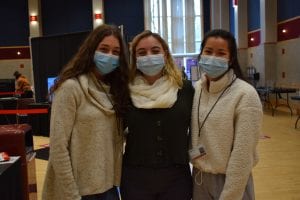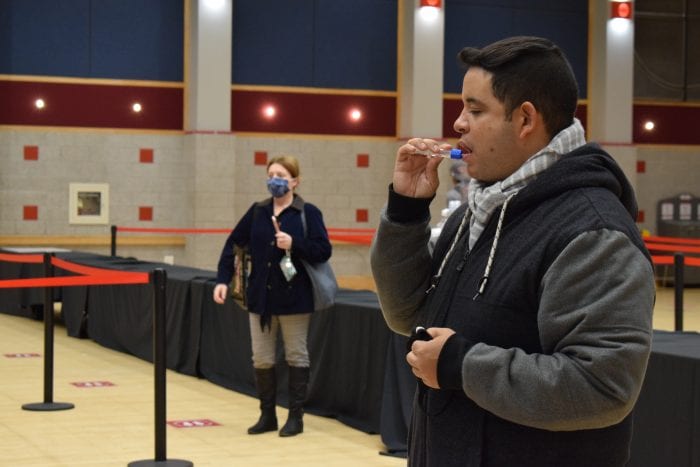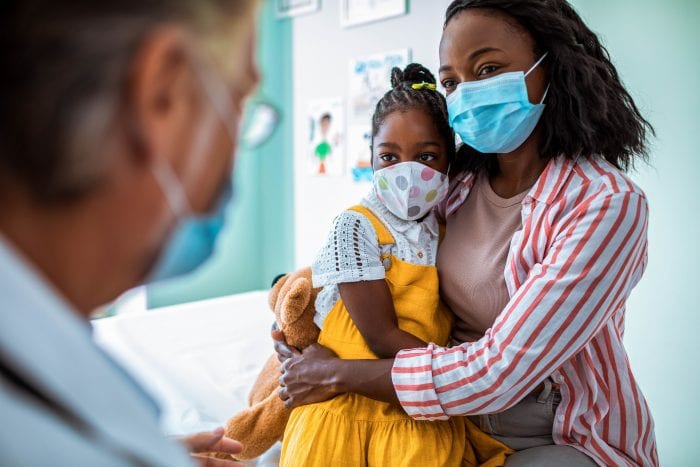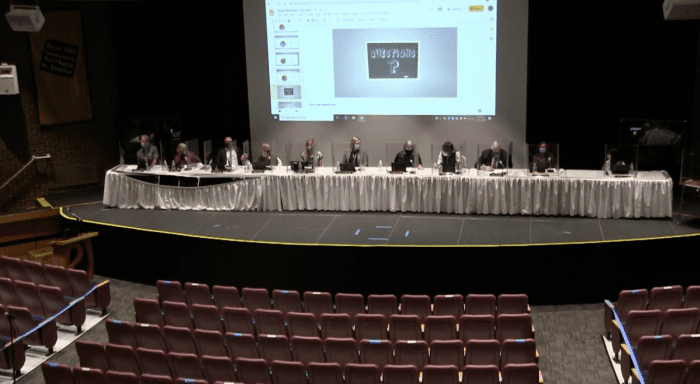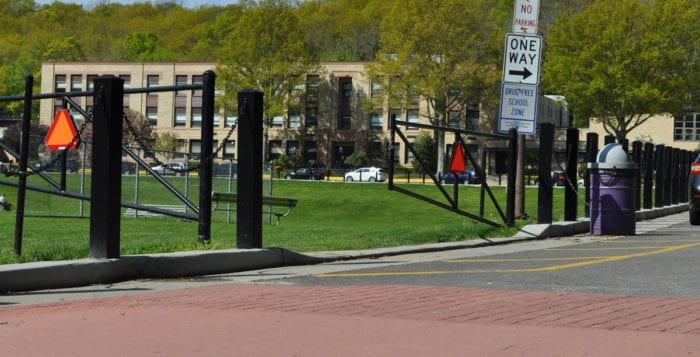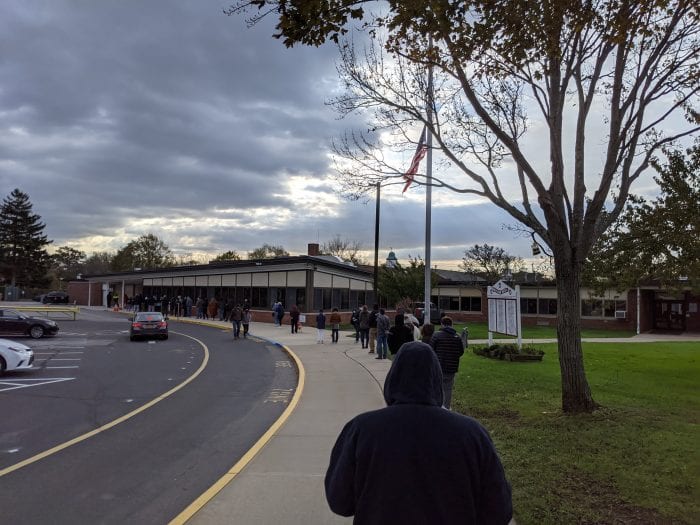By Kyle Barr, Rita J. Egan and Julianne Mosher
Capping off months of anticipation, the 2020 election came to a head Tuesday night, though New Yorkers will still need to wait weeks before they know the true outcomes of state and federal races.
As it stands, Republicans have taken an early lead based on unofficial counts of in-person polling numbers by the Suffolk County Board of Elections. Nick LaLota, Republican BOE commissioner, said absentee ballots will start to be tabulated Nov. 10 after the board has had the opportunity to remove the absentee ballots of those voters who also cast a ballot on a machine, and have bipartisan teams compare the signatures on the oath envelopes to the voters signatures on file.
There have been well over 100,000 absentee ballots received in Suffolk County for the three congressional districts alone, and there will likely be more incoming as ballots are received as long as they were postmarked by Election Day. Election experts have also said those absentee ballots are more likely to favor Democrats.
In one of the most contested races for the NY1 Congressional seat, Lee Zeldin has already moved to declare victory. Zeldin is sitting at 61% of in-person votes while Goroff holds a little under 39%. The Zeldin campaign released a statement declaring victory at 11 p.m. Election Day.
“I am deeply honored and humbled that the families of Long Island have entrusted me to continue representing our great Congressional District,” Zeldin said in a statement.
Democratic contender Nancy Goroff’s campaign manager, Jacob Sarkozi, responded at 1:30 a.m. that, “With tens of thousands of ballots left to be opened, we owe it to voters that every single one be counted.”
There are currently 75,091 absentee ballots for CD1 uncounted as of Nov. 4.
Speaking to Goroff the evening of Nov. 3, before polls closed, she said the huge turnout in the district has been “amazing,” adding there has been a good deal of excitement about the coming results.
While in-person votes were still to be counted as of Election Day, with the thousands of absentee ballots still to be counted, she stressed it’s still too early to tell winners with any degree of certainty, but added the turnout is a good sign.
With an energized electorate not seen in many years, polling places across Long Island saw a huge rush early in the morning Nov. 3, with residents across the North Shore reporting hour or more wait times in chilling temperatures. Lines got progressively shorter over the day, and by 8:30 a.m. people were reporting between 20- to 40-minute lines.
The night of Nov. 3, both Suffolk County party committees held online livestream events, rather than the usual election parties held at Stereo Garden in Patchogue for the Republicans and IBEW Local 25 in Hauppauge for the Democrats. The Dems palled around in a short hour-long Zoom call before signing off. The Republicans spent the night taking calls from candidates and committee members, relishing the early polling numbers.
Other congressional races have similarly stalled at a Republican lead. U.S. Rep. Tom Suozzi (D-NY3) is currently sitting at 47% to Republican challenger George Santos at 53%.
Kim Devlin, a senior adviser to Suozzi’s campaign, said in a statement they believe Suozzi is guaranteed to win.
“It is clear that Tom will win reelection by a substantial margin,” Devlin said. “Democrats hold a 3-1 advantage in the nearly 90 thousand absentee votes yet to be counted and we expect Tom’s margin of victory to be over 20 thousand votes.”
For state Senate, the race between Democrat Laura Ahearn and current Assemblyman Anthony Palumbo (R-New Suffolk) in District 1 is locked at 43% to 57%, respectively.
Palumbo said in a statement he is “really excited about our position today and [I] feel good about our likelihood of success,” adding he is honored to be close to representing the district occupied by state Sen. Ken LaValle (R-Port Jefferson).
Ahearn said in a statement that “while the early vote and Election Day in-person vote was not as close as we had hoped,” with more 31,000 mail-in ballots still to be counted, there is a need to be patient and ensure all ballots are counted. She also thanked her supporters, as well as her campaign staff, interns and volunteers “for their dedication and commitment.”
In SD2, Republican Mario Mattera holds a near-30 point lead over his Democratic opponent Mike Siderakis at 64%-36% Wednesday morning. Mattera said he was grateful for all the volunteers who assisted in the campaign.
“I’m so excited for my community,” he said. “I’m so excited for our families.”
Once in Albany, Mattera, who describes himself as “a middle-of-the-road guy,” said he will work to repeal the bail reform act and ensure funding for law enforcement. Continuing to educate the public about precautions to take during the pandemic and helping businesses to open up fully is also on the forefront of his mind. He added he will continue to work on improving the infrastructure in the district. Mattera worked with elected officials and community leaders on the revitalization of Lake Avenue in St. James. He said it’s important to secure a sewage treatment plant that will allow for growth in the area and at the same time will protect local waterways.
Siderakis did not respond to request for comment.
Republican Ed Smyth, who is currently a Town of Huntington councilman, was leading Wednesday morning in the race for state Senate in SD5 with more than 55% of the votes. Sitting state Sen. Jim Gaughran (D) at 43% is vying for his second term.
“I’m not ready to hang a mission-accomplished banner over my office,” Smyth said.
The councilman said he will be watching the results closely as he knows thousands of absentee ballots still need to be counted, and from what he has heard, more Democrats than Republicans requested absentee ballots.
“There’s nothing normal about this election year,” he said.
Gaughran’s spokesperson Marissa Espinoza also said it was too early for anyone to declare victory.
“There are nearly 30,000 absentee votes, the majority of which appear to be from Democrats,” she said. “It is vital that every vote be counted. I’m confident that this full count will favor Senator Gaughran.”
For state Assembly, there are some tight and other not-so-tight races. Republican Jodi Giglio is standing at 62% to her Democratic opponent Laura Jens-Smith’s 36% in District 2.
Jens-Smith said during a phone interview Nov. 4 though there are still ballots to count, it’s likely her opponent has the ball. She said the day’s results show that Democrats need to focus on “rebuilding our base here to make sure that the issues we campaigned on are getting out to the voters better.”
She said she will continue to stay involved in the area, especially to make sure “we continue to have working and middle class here on Long Island.”
Giglio said she was holding on any declarations until all absentee votes are counted, but she thanked GOP leadership, her volunteers and her support from law enforcement and labor.
“Every vote means something to me and I am humbled by the confidence in me from the voters and the vote count thus far,” she said.
28-year incumbent Assemblyman Steve Englebright (D-Setauket) is behind his Republican opponent Michael Ross by close to five points in Assembly District 4 at 47%-52%. There are well over 15,000 absentee ballots to be counted, as of Nov. 4.
Englebright said he is not too concerned at the current polling numbers, as because of the pandemic and so many people voting differently, “I think we’ll be OK … a very substantial number of people who voted absentee ballot — a majority are my vote.”
Ross said he remains cautiously optimistic.
“I think that across the board on the Island, the middle class spoke loudly for the Democrats to hear that they’re tired of the Albany agenda, and they’re tired of being ignored and their voices not being heard,” he said.
The day’s vote disparity is most drastically seen in Assembly District 8, with incumbent Mike Fitzpatrick (R-St. James) holding more than 70% of the vote compared to Democratic challenger Dylan Rice’s 29%.
Fitzpatrick said while “the dust still has to settle,” he feels good about where he’s at.
“It was just an unusual campaign,” he said. “I’m used to being out and about in front of people. We did a couple of events, but certainly not like past campaigns.”
Rice did not respond to a request for comment.
In the 12th Assembly District, Republican Keith Brown had more than 57% of the vote, while Democrat Michael Marcantonio had more than 42% of the votes Wednesday morning.
Brown said while he feels good about the lead but he’s not ready to claim victory yet.
“Every vote is important and has to be counted,” he said.
The candidate said his campaign was one based on character and his experience with getting things done, and he was humbled by the support he received from family, friends, the Republican, Conservative and Independent parties as well as law enforcement organizations.
Marcantonio said he was being patient with results and optimistic for him and other Democrats who are currently trailing.
“This is going to look like a very different race in two weeks when all these votes are counted,” he said.
The Democrat said as of Wednesday morning four polling places in the district were not yet counted, and based on conversations his campaign has had with the board of elections and based on other data they have received, there are a little under 13,000 absentee votes that still need to be counted. Marcantonio is down by 8,000 votes.
“The race is far from over,” he said.
The candidate said he knew the race would be a close one, and he congratulated Brown on the strong showing and appreciated the Republican for not declaring victory just yet.
Republican Jamie Silvestri and incumbent Steve Stern (D-Dix Hills) are close to a tie at about 50% each in Assembly District 10, with over 15,000 absentee ballots still to be counted.
“I’m very grateful for all the incredible people who stood by me and supported me throughout the year,” Silvestri said in a phone interview Nov. 4. “I’m optimistic for what’s ahead.”
Stern said that while the numbers are close, there are ballots to be counted over the next week. “It’s a very close race,” he said. “However, there still is a long way to go over the course of the next week in making sure every vote is counted, and when that process is complete I have every confidence that I will have the privilege to represent my community.”
